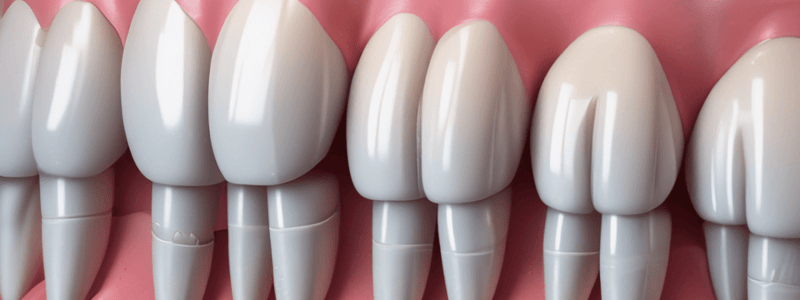Podcast
Questions and Answers
What is the main cause of abfraction?
What is the main cause of abfraction?
What is the clinical feature of abfraction lesions?
What is the clinical feature of abfraction lesions?
Where are the maximal abfractive stresses generated?
Where are the maximal abfractive stresses generated?
What is the result of tensile and compressive stresses in the cervical region?
What is the result of tensile and compressive stresses in the cervical region?
Signup and view all the answers
What can cause the loss of bonded Class V restorations?
What can cause the loss of bonded Class V restorations?
Signup and view all the answers
What is the effect of tooth flexure on dentin?
What is the effect of tooth flexure on dentin?
Signup and view all the answers
What is the range of intra-oral loads reported in the literature?
What is the range of intra-oral loads reported in the literature?
Signup and view all the answers
What is the functional load considered clinically normal?
What is the functional load considered clinically normal?
Signup and view all the answers
What is erosion defined as in relation to tooth surface?
What is erosion defined as in relation to tooth surface?
Signup and view all the answers
What is the main cause of intrinsic erosion?
What is the main cause of intrinsic erosion?
Signup and view all the answers
Which of the following is NOT a medical condition associated with intrinsic erosion?
Which of the following is NOT a medical condition associated with intrinsic erosion?
Signup and view all the answers
What is the name of the disorder characterized by repeated episodes of binge eating and self-induced vomiting?
What is the name of the disorder characterized by repeated episodes of binge eating and self-induced vomiting?
Signup and view all the answers
What is the name of the disease characterized by regurgitation without nausea or abdominal contractions?
What is the name of the disease characterized by regurgitation without nausea or abdominal contractions?
Signup and view all the answers
What is the age range of young women most commonly affected by dental erosion due to chronic vomiting?
What is the age range of young women most commonly affected by dental erosion due to chronic vomiting?
Signup and view all the answers
What is the term for the syndrome consisting of repetitive, effortless regurgitation of undigested food?
What is the term for the syndrome consisting of repetitive, effortless regurgitation of undigested food?
Signup and view all the answers
What is the occupation most commonly associated with extrinsic erosion?
What is the occupation most commonly associated with extrinsic erosion?
Signup and view all the answers
What is the primary goal of management for non-carious lesions?
What is the primary goal of management for non-carious lesions?
Signup and view all the answers
What is a consideration for initiating restorative management of non-carious lesions?
What is a consideration for initiating restorative management of non-carious lesions?
Signup and view all the answers
What is the purpose of occlusal guard therapy?
What is the purpose of occlusal guard therapy?
Signup and view all the answers
What is a requirement for a comprehensive examination of non-carious lesions?
What is a requirement for a comprehensive examination of non-carious lesions?
Signup and view all the answers
What is the purpose of beveling the enamel margin and roughening the internal walls in Class V tooth preparation?
What is the purpose of beveling the enamel margin and roughening the internal walls in Class V tooth preparation?
Signup and view all the answers
What is a type of non-carious lesion that requires restoration or protection?
What is a type of non-carious lesion that requires restoration or protection?
Signup and view all the answers
What is a condition that may indicate the need for occlusal guard therapy?
What is a condition that may indicate the need for occlusal guard therapy?
Signup and view all the answers
What is a consideration for restorative management of non-carious lesions?
What is a consideration for restorative management of non-carious lesions?
Signup and view all the answers
Study Notes
Abfraction
- Definition: Strong eccentric occlusal force resulting in microfractures at the cervical area of the tooth, causing wedge-shaped defects.
- Etiology: Caused by tooth flexure in patients with abnormal occlusal interactions.
- Mechanism: Tooth flexure generates lateral or axial bending, leading to tensile and compressive stresses, strain, and microfractures in cervical enamel.
Clinical Features of Abfraction
- Characteristics: Sharp notch or wedge-shaped lesions, not saucer-shaped defects.
- Location: Maximal abfractive stresses occur at the cervical area, thinnest region of enamel at the cementoenamel junction (CEJ).
- Consequences: Loss of bonded Class V restorations, enamel loss, and pulpal inflammation.
Treatment of Abfraction, Erosion, Abrasion, and Attrition
- Considerations for restorative management:
- Defect compromises structural integrity of the tooth.
- Intolerable sensitivity exists.
- Area affected by caries.
- Defect contributes to periodontal problem.
- Area involved in removable partial denture design.
- Defect depth is close to the pulp.
- Defect is actively progressing.
- Patient desires esthetic improvements.
Non-Carious Lesions and Management
- Definition: Various non-carious causes of tooth loss and management strategies.
- Erosion: Wear or loss of tooth surface by chemical action in the presence of demineralizing agents with low pH.
Classification of Erosion based on Etiology
- Intrinsic Erosion:
- Caused by endogenous acids of gastric origin.
- Associated with:
- Recurrent vomiting (eating disorders).
- Medical conditions (gastrointestinal, metabolic, endocrine, neurological disorders, etc.).
- GERD (Gastro Esophageal Reflux Disease).
- Rumination syndrome.
- Extrinsic Erosion:
- Caused by extrinsic factors.
- Associated with:
- Occupational factors (professional wine tasters).
- Other extrinsic etiological causes.
Studying That Suits You
Use AI to generate personalized quizzes and flashcards to suit your learning preferences.
Related Documents
Description
Learn about abfraction, a dental condition caused by strong eccentric occlusal forces, resulting in microfractures at the cervical area of the tooth. Explore the etiology and effects of intra-oral loads on teeth.




